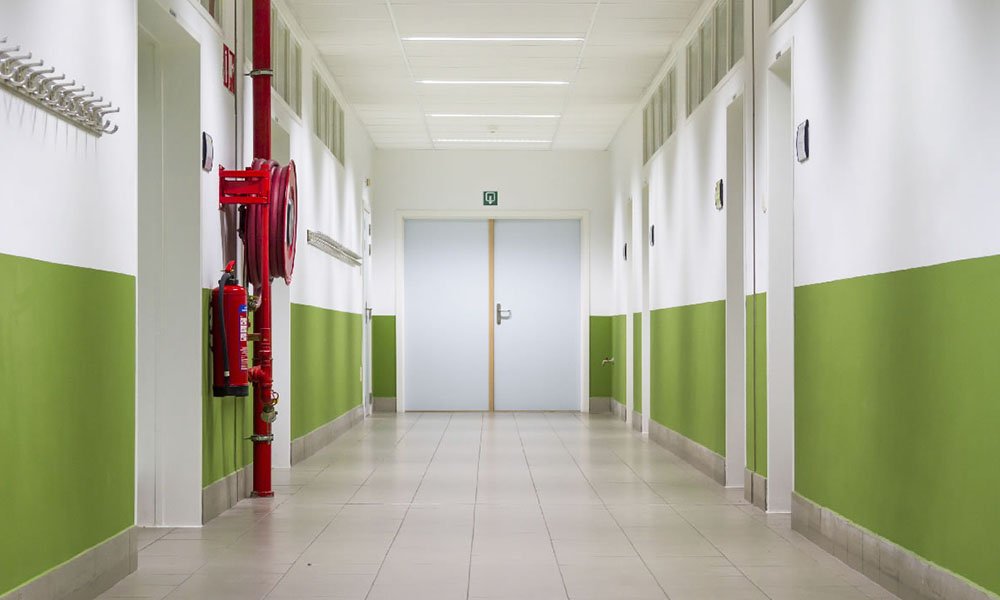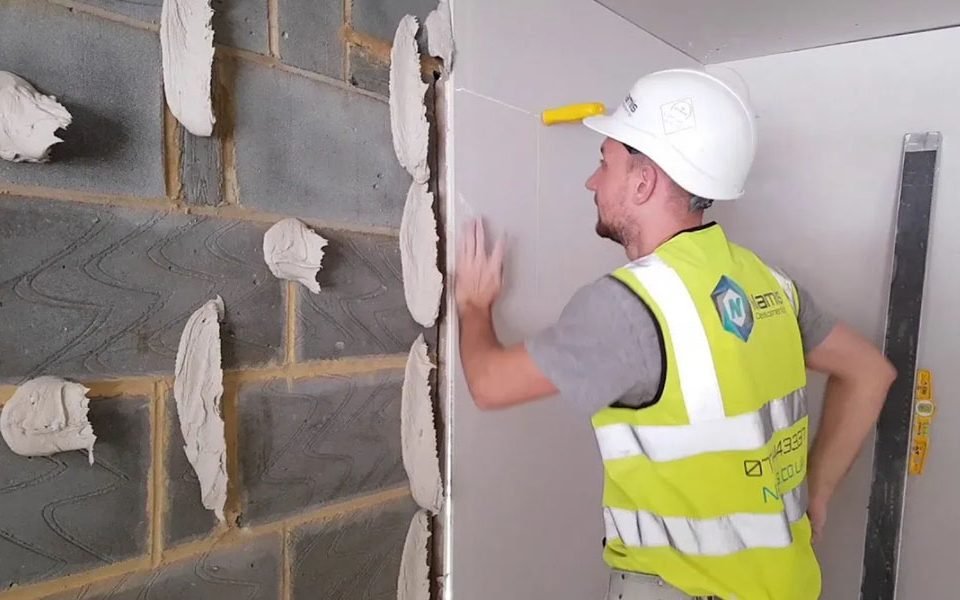Plasterboard is one of the most widely used construction materials today. It is a dried panel of gypsum, sandwiched between two pieces of specialised paper lining. It has been in use since the 1950s as an alternative to traditional lath and plaster, and now is the preferred choice for interior wall partitions and ceilings. Compared to other construction materials, like plywood and fibreboard, plasterboard is much easier to work with, quicker to install and fares better in a range of different settings.
The benefits of plasterboard don’t end here. Even regular plasterboard panels have high levels of fire resistance, with the gypsum core being non-combustible and in a potential fire has low flame spread and low smoke density. The same panel has high sound insulation, and as such, is ideal in areas with high noise levels like factories, warehouses and offices. Including different additives to the gypsum, and using different backing and facer materials in the lining lends to different types of plasterboard suitable for a variety of uses.
Table of Contents
Where Is Plasterboard Used?
Plasterboard is mainly used for lining existing walls or creating wall partitions in a given space. For these applications, you can choose between two different cuts to the panels – square and tapered edge plasterboard, each giving off its own unique finish.
Plasterboard panels are also widely used for ceilings both in residential and commercial settings and to create design features like arches, decorative cabinets, and curved walls. Boards are flexible and easily shaped to almost any existing surface, while also having enough rigidity to function as standalone walls. Newer variants with high moisture resistance, are used as external sheathing and insulation in exterior walls.
Other settings where plasterboard can be used besides homes are office buildings, retail shops, hospitals, libraries, warehouses and more. Being a low-cost and versatile building material, it is also good for a range of different finishes and is easy to paint over. If and when you decide to re-arrange plasterboard walls or ceilings, the material is just as easy to remove as it is to install.
Types of Plasterboard
Three factors – density and thickness, additives, and the lining materials contribute to different properties and types of plasterboard. Some common types include.

Acoustic or Sound Resistant Plasterboard
This is produced with a denser and thicker gypsum core (in 12.5mm or more) and is often lined with other insulative materials, like fibreglass or mineral wool, to deaden out outside noise. When used with adhesives to seal air pockets and gaps, it further increases sound insulation. Boards like these are often ideal for home studios, music stores and schools, and any wall or ceiling in high-noise areas.
Fire-Resistant Plasterboard
Gypsum laced with a special glass fibre gives this type of plasterboard exceptional fire resistance. Depending on the thickness of the board, fire resistance can last between 30 minutes in thinner boards to over two hours in thicker variants. Good if you need to meet UK building standards and fire requirements. A fire-resistant board is good in all settings, particularly for lining timber stud walls.
Moisture Resistant Plasterboard
When renovating bathrooms, or concealing piping and plumbing you’ll need moisture resistant plasterboard. This is easily recognisable by the green lining and consists of moisture repellent additives mixed in with the gypsum. Related vapour resistant plasterboard has an additional metallic foil in areas where humidity, condensation and resulting mould are problematic.
Insulated Plasterboard
This is also called thermal board, and is essentially two boards in one– a denser insulated and thinner plasterboard bonded together. They’re typically thicker, with some boards coming in at 150mm, and can have different linings for better insulation and moisture performance. Insulated plasterboards are inexpensive options for reaching better thermal efficiency in your home or business, and help in reducing energy bills.
Impact Plasterboard
Also called dense plasterboard because of thickly packed gypsum (often mixed with fibreglass) and backed with dense paper or wood. This is found in areas with high foot density, like schools, hospitals, airports and offices where the chance of accidental damage is higher.
External sheathing boards, sound and moisture boards and plasterboard planks are some of the other types. Lastly, let’s not forget the standard (white) plasterboard that is the most common type for interior walls and ceilings. This has good insulation, sound and moisture resistance as it is, and is also the cheapest to buy.
Dimensions and Designs
Standard plasterboard is sold in regular wall heights (2400, 2700 and 3000mm) and usually 900 or 1200mm in width. This means that it’s installed vertically for walls, from floor to ceiling, so you get cleaner and neater finishes with minimal or no gapping. There are smaller sizes of plasterboard that are used for decorative purposes. Thickness also varies. Besides the specialist boards motioned above, the standard plasterboard is either 12.5 or 15mm thick.
Tapered Edge vs Square Edge
These are the two basic designs in terms of the edges of each panel. The tapered edge plasterboard has an angular slope cut out of the edge. The other option is a plasterboard with a square edge design. There are pros and cons to each type, and this relates to the type of finish you require as well as how individual boards are jointed. It also means different applications.
Tapered plasterboard is ideally used for walls. This has a lot to do with the sloped edges that allows for easier jointing. The tapered edges meet and create a recessed triangle and can then be filled with pre-mixed or prepared joint compound or filler. The resulting finish is even and smooth so there’s no need for additional coating in what is known as skimming.
Tapered edge boards also better handle the use of scrim jointing tape, necessary in sealing any gaps between separate panels. This is easily applied along the seams and any air pockets or bulges are removed by applying pressure with a trowel along the length of the seam.
Whether using this technique or compound filler, tapered edged boards require little other work before the jointed panels are ready for painting. This is when joints completely disappear from sight. The finished wall then can also be prepared with acrylic primer and adhesive if you find the need to add tiles.
This means that for interior walls, using boards with tapered edges saves time, as installation is relatively straightforward. One thing to note is that it is for straight walls, whereas corners and angled walls are better served with square edge plasterboard.
Square edge plasterboard is simpler in design so easier to make and less expensive. The edges of separate panels are harder to align for a smooth and even finish as with tapered edge plasterboard, as taping almost always creates bulges. That’s why this type of plasterboard regularly requires skimming. If you’re after a textured rather than a smooth look, then squared edge boards are a better and cheaper choice. They’re ideally used for constructing suspended ceilings as the edges align better for overhead applications.
The Benefits of Plasterboard
Plasterboard is cheap, lightweight and a breeze to install. It is also very versatile and can be used in different rooms and areas with the boards sourced with the right lining and additives. It meets UK building regulations, has good rigidity, prevents mould and humidity buildup and creates a quiet and relaxing living space. Plasterboard panels come in a variety of sizes and thicknesses for your application, and in tapered or square edge designs depending on the finish and where they’re used. Plasterboard is also good for a range of practical and decorative uses, limited only by your imagination.










